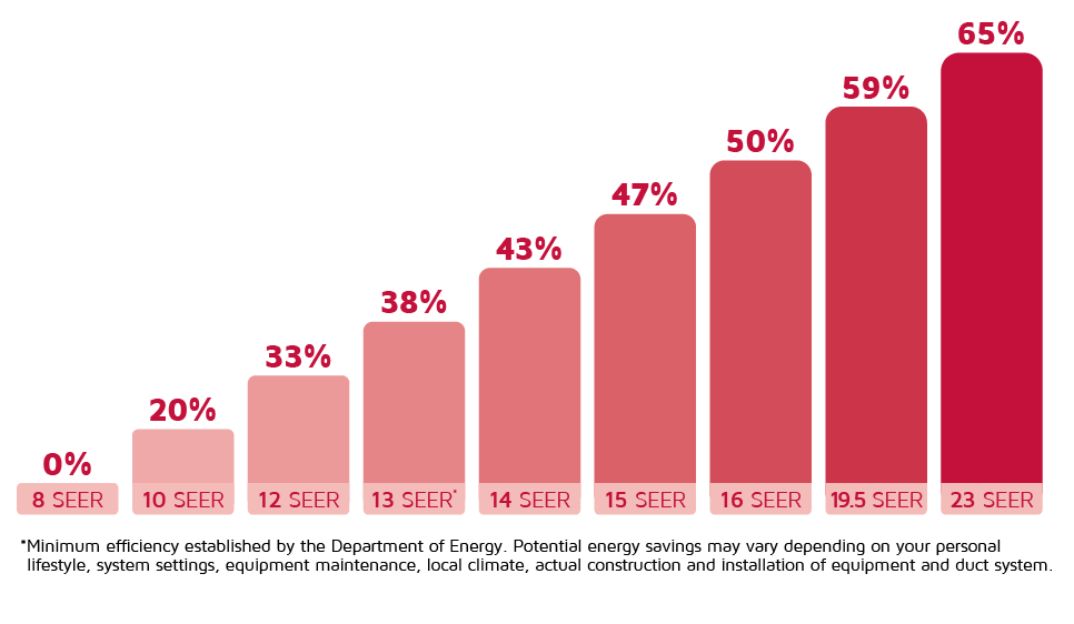

SEER vs. SEER2:
Exploring
the Basics
SEER has long been the benchmark for measuring the energy efficiency of air conditioning systems. It represents the ratio of the cooling output of an air conditioner over a typical cooling season, divided by the energy it consumes in Watt-hours. Essentially, SEER indicates how efficiently an HVAC system operates over an entire season.
To better accommodate new product regulations and minimum efficiency standards, the Department of Energy (DOE) introduced SEER2.
SEER2, which stands for Seasonal Energy Efficiency Ratio 2, introduces a more comprehensive and accurate approach to assessing HVAC system efficiency. SEER2 takes into account various factors that were previously overlooked in the SEER calculation, offering a more precise reflection of real-world performance. This includes raised external static pressure testing to more closely mimic a typical ducted system in a typical residential setting.
Key Differences and
Factors Considered
The primary disparity between SEER and SEER2 lies in the factors considered during the efficiency calculation. While SEER predominantly focuses on nominal conditions, SEER2 incorporates additional variables such as part-load performance, temperature variations, and occupancy patterns. Let’s delve into these factors:

Part-Load Performance
SEER2 accounts for how efficiently an HVAC system operates at partial loads, which is often the case in real-world scenarios. This aspect is crucial as it reflects the system’s ability to adjust its output based on the actual cooling demands, leading to more accurate efficiency ratings.

Temperature Variations
Unlike SEER, which typically considers fixed temperature conditions, SEER2 takes into consideration the varying temperatures experienced throughout a cooling season. This adjustment provides a more realistic assessment of energy consumption and efficiency across different climate regions.

Occupancy Patterns
SEER2 acknowledges the impact of occupancy patterns on HVAC system operation. By considering factors such as occupancy schedules and usage fluctuations, SEER2 offers a better representation of energy usage in residential and commercial settings.
Implications for HVAC Dealers
Understanding the disparities between SEER and SEER2 is vital for HVAC dealers for several reasons:
Accurate Performance Assessment: With SEER2 offering a more precise evaluation of HVAC system efficiency, dealers can provide customers with accurate information about energy savings and performance expectations.
Enhanced Customer Satisfaction: By recommending HVAC systems with higher SEER2 ratings, dealers can ensure that their customers enjoy improved comfort and energy efficiency, leading to greater satisfaction and loyalty.
Compliance and Regulations: As SEER2 becomes increasingly adopted as the standard for efficiency ratings, dealers must stay compliant with regulations and guidelines set by regulatory bodies and energy efficiency programs.


What SEER2 Means
for Homeowners
The introduction of SEER2 regulations offer many benefits to homeowners by establishing higher efficiency requirements for air conditioning units.
Due to these new ratings, SEER2-compliant units are designed for optimal energy usage, reducing wasted energy - and their energy bills. A lot of these upgraded systems qualify for regional and federal rebates and tax credits . Encourage your customers to see if they qualify when they upgrade to a SEER2-compliant unit.
However, it’s crucial to consider the costs associated with SEER2-compliant AC units. Generally, these units tend to be more expensive upfront compared to non-compliant units. This is due to the advanced technologies and components used to achieve higher energy efficiency. However, the long-term energy savings can often outweigh the initial investment, making SEER2-compliant units a smart choice for homeowners looking to reduce their carbon footprint and save on utility bills.
Choosing the right SEER2-compliant AC unit is crucial to maximize energy savings and comfort. There are a few factors to consider when selecting a unit that best fits your clients’ needs. First, determine the cooling capacity required for their home. This is measured in British Thermal Units (BTUs) and depends on factors such as the size of their home, insulation, and climate. Next, consider additional features and technologies that can enhance comfort and convenience, such as variable speed compressors and smart thermostats.
At LennoxPros, we offer a wide range of SEER2-compliant AC units that are designed to deliver exceptional efficiency and comfort. Our products are built with industry-leading technologies and undergo rigorous testing to ensure reliable performance. Whether you’re looking for a residential or commercial solution, our knowledgeable team can help you choose the right SEER2-compliant AC unit that fits your specific requirements.
The transition from SEER to SEER2 signals a significant advancement in the assessment of HVAC system efficiency. As HVAC dealers, it’s essential to grasp the disparities between these two metrics and their implications for both your business and your customers. By embracing SEER2 and its comprehensive approach to efficiency evaluation, dealers can elevate their service standards, drive customer satisfaction, and contribute to a more energy-efficient future.

